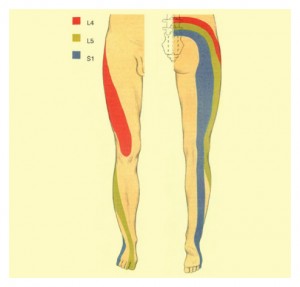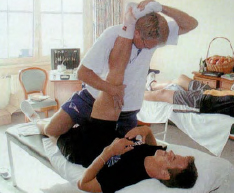If you have a Sports Hernia there are often no obvious external symptoms or signs.
However, you generally experience a deep or sharp pain and discomfort from your lower abdomen and pelvis to your urogenital and groin area (your lower stomach muscles around to your pubic bone and under to the bottom of your body between your legs) especially with sudden movements or when exerting yourself in activities that involve kicking, twisting, side-stepping, sprinting, and lifting. Some people experience testicular pain as well. Activities that increase intra-abdominal pressure like resistance sit-ups, coughing or sneezing can aggravate the pain. You will often feel pain and tenderness on one side of the abdomen or groin near the pubic tubercle (bump), which radiates into the genital area, and can move down into the hip and/or inner thigh area.
This pain and accompanying stiffness can be experienced during or after activities, and can last for hours or weeks. You may find it difficult to get out of your car a few hours after your activity and/or find it hard to get out of bed the next morning. Your Sports Hernia pain will often go away with rest, however it generally returns when you resume the activity.
Weakness in the upper thigh area with adduction (bringing upper leg or hip closer to the centre of your body) can be seen and/or experienced with a Sports Hernia when running, walking or kicking.
Should You Seek Medical Attention?
This is up to your discretion; however any continued discomfort in your groin or pelvis area should be investigated. If you continue to experience the Sports Hernia symptoms noted above and have tried the suggested conservative treatments (see conservative treatments for sports hernias), it is recommended that you seek professional medical attention. If you experience any of the symptoms noted below it is recommended that you seek immediate attention:
- Severe pain and tenderness.
- Problems or swelling in or around the genitalia (penis, scrotum, testicles).
- A cut, lump or bulge or bleeding in your groin area.
- Major hip/thigh movement problems causing a severe limp.
- Urinary problem.
- A groin rash.
- Postoperative problem after groin operation.
- Exposure to an STD.
- Groin pain has not improved after 1 week, where symptoms are more severe or frequent.
- Signs of shock (lightheadedness, restlessness, shallow breathing, sweating, weakness, nausea.)
Groin Injury Treatments
If you have a muscle pull or strain in your groin, resting it is recommended. Avoid activities that cause pain or may have caused the injury and begin cold compression treatments as soon as possible.
There are healing tools that can help treat your groin strain and speed up the healing process so you can reduce your pain and get back to daily life.Blood Flow Stimulation Therapy™ (BFST®) will promote blood flow to heal your injury faster and more completely than any other methods available.

